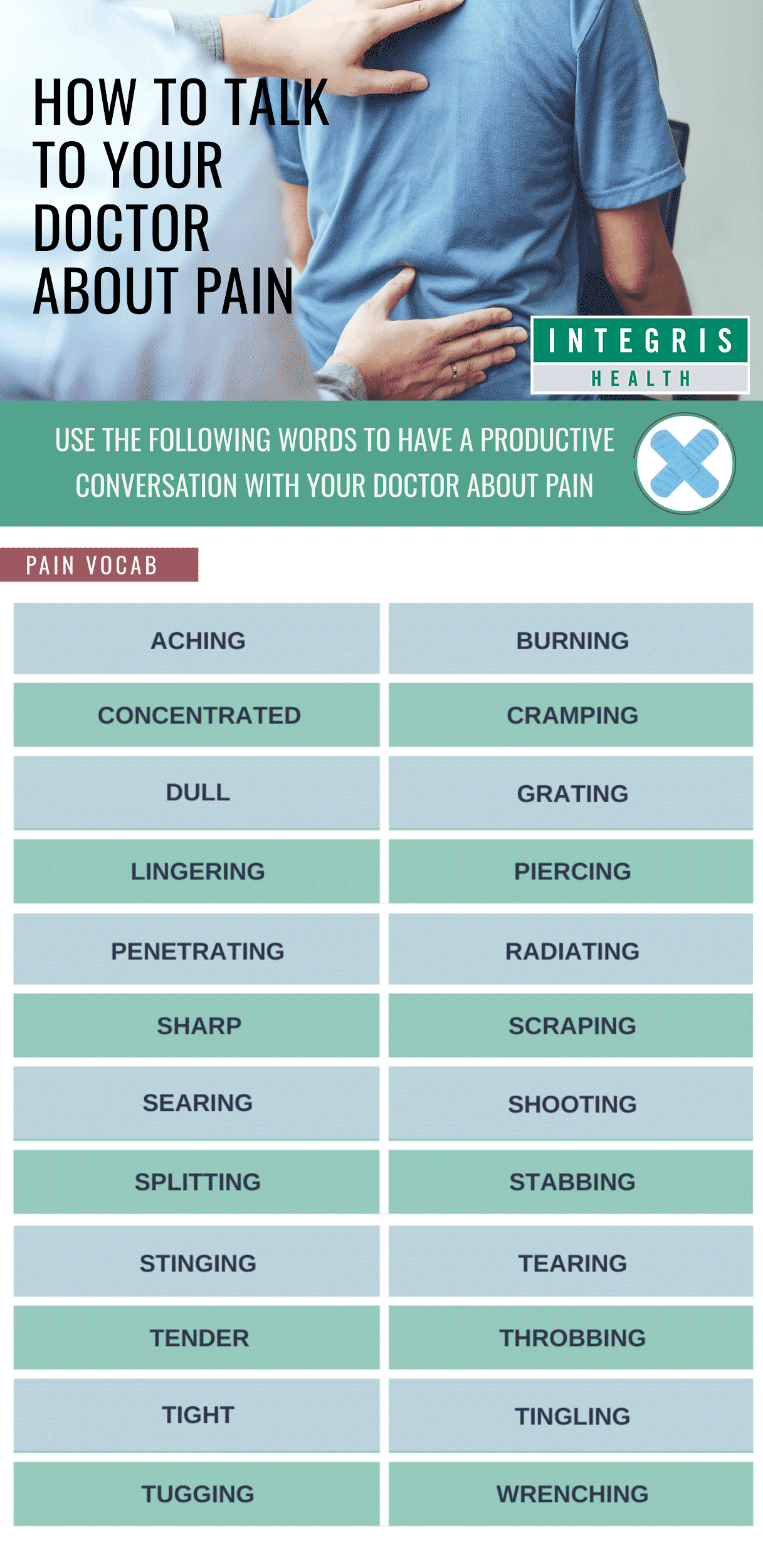How To Talk To Your Doctor About Pain

You’ve likely visited your doctor for a stabbing sensation, an uncomfortable tingle or a dull ache at some point.
Your doctor might have presented you with a numerical scale, asking you to rate your pain from 0 to 10, with zero being no pain at all and 10 being excruciating. Or you might have seen a sad-to-happy-face scale instead. Those can be jumping-off points to help your doctor understand your pain level, but what helps them whittle down to a diagnosis is your words, or how you describe your pain.
If you’re like most patients, you probably didn’t have a problem identifying the location of the pain, or how long it persisted, but you might have struggled when relaying how intense the pain actually was and what it felt like.
Oftentimes patients find it difficult to grasp the right words to describe pain, or they worry they’ll unintentionally exaggerate it or minimize it through the words they use. And let’s face it: It’s your health, so there’s a lot at stake. Inaccurate descriptions can lead to misdiagnoses, misaligned treatments to manage the pain or an ailment going undiagnosed altogether.
To arm you with the vernacular you need to describe pain during your next doctor’s visit, we put together a guide to help you and your physician see eye to eye on your pain level so you can get to work alleviating or managing it.
What is pain?
Before you consult your doctor about your pain, it might be a good idea to brush up on the fundamentals of what pain is.
Have you ever stepped into a too-hot bath? The scorching water likely caused a burning sensation to spread through your skin. Those are your pain receptors at work. Pain receptors are found on the inside and outside of your body. When you experience pain, these receptors are sending electrical messages through your spinal cord to your brain. You become aware of pain after your brain receives and interprets the messages.
The messages’ starting point and the route they travel to your brain has a lot to do with how you perceive pain. That’s because pain receptors and nerve pathways differ throughout the body.
Acute vs. chronic pain
Pain is typically classified two ways: acute or chronic.
Acute pain is often severe and short-lived, coming on suddenly and caused by something specific. It’s typically a sign that your body has been injured. This type of pain can last a second, or it can last weeks or months. Acute pain also can increase heart and breathing rates and raise blood pressure. Examples of acute pain are stepping into a hot bath, hitting your funny bone and getting a paper cut.
On the other hand, chronic pain can come and go but ultimately is long-lasting. It can either be mild or severe and is often the result of a disease that may require ongoing treatment. Chronic pain is linked to conditions including arthritis, back pain, cancer, fibromyalgia pain, headache and nerve pain and is often treated through long-term pain medications.
Chronic pain lasts six months or longer and continues even after the injury or illness that caused it has healed or gone away. It can disturb sleep patterns, decrease appetite and cause depression.
Pain vocabulary to use at your next appointment
Now that you understand what pain is and the two types of pain, you can work on finding the words to describe the specific pain you’re experiencing. Is it dull or sharp? Does it radiate or is it concentrated? Consider how it feels to you and come to your doctor’s appointment prepared with your most-detailed description of the pain.
Consult our pain vocabulary chart below and see if any of the words align with the discomfort you’re experiencing. Remember, it’s not an exhaustive list and you may experience sensations not described below.
Additional ways to prepare for your doctor’s visit
In addition to being able to articulate the location of your pain, how long it’s persisted and how intense the pain is, you can prepare for your doctor’s appointment in several other ways as well.
- Share your previous treatments: Have you tried acupuncture or physical or massage therapy? Do these treatments relieve pain or aggravate it? Are you currently on a medication to treat the pain? These are all things your doctor can use to get a better understanding of your health history and reach a diagnosis.
- Describe how the pain affects your life: How has the pain stopped you from doing the things you enjoy? If you’re an avid knitter whose aching knuckles no longer allow you to knit and purl, you might tell your doctor, “I’ve enjoyed knitting as a hobby for years, but the pain in my hands is now so unbearable I can’t bring myself to even pick up my knitting needles.” Supplying an anecdote could drive home to your doctor the severity of your pain.
- Log your pain in a pain journal: As soon as you realize you have a lingering pain that might require a doctor’s visit, start logging your pain in a journal. Try your best to remember the date you first noticed the pain and the pain level you experienced. How did it change from day to day? How did it hinder your daily activities?
- Jot down questions: Come to the appointment prepared with questions for your doctor. It’s easy to say you’ll remember them once you’re at the appointment, but there’s a lot to cover and if you don’t have questions in hand, they might get overlooked.
Take the first step to manage your pain
Whether you’ve experienced a sudden pain or you’ve lived with pain for years, the physicians at INTEGRIS can help you manage your pain and start living a more comfortable life. Take the first step: Talk to your INTEGRIS doctor about treatment options that are right for you.

